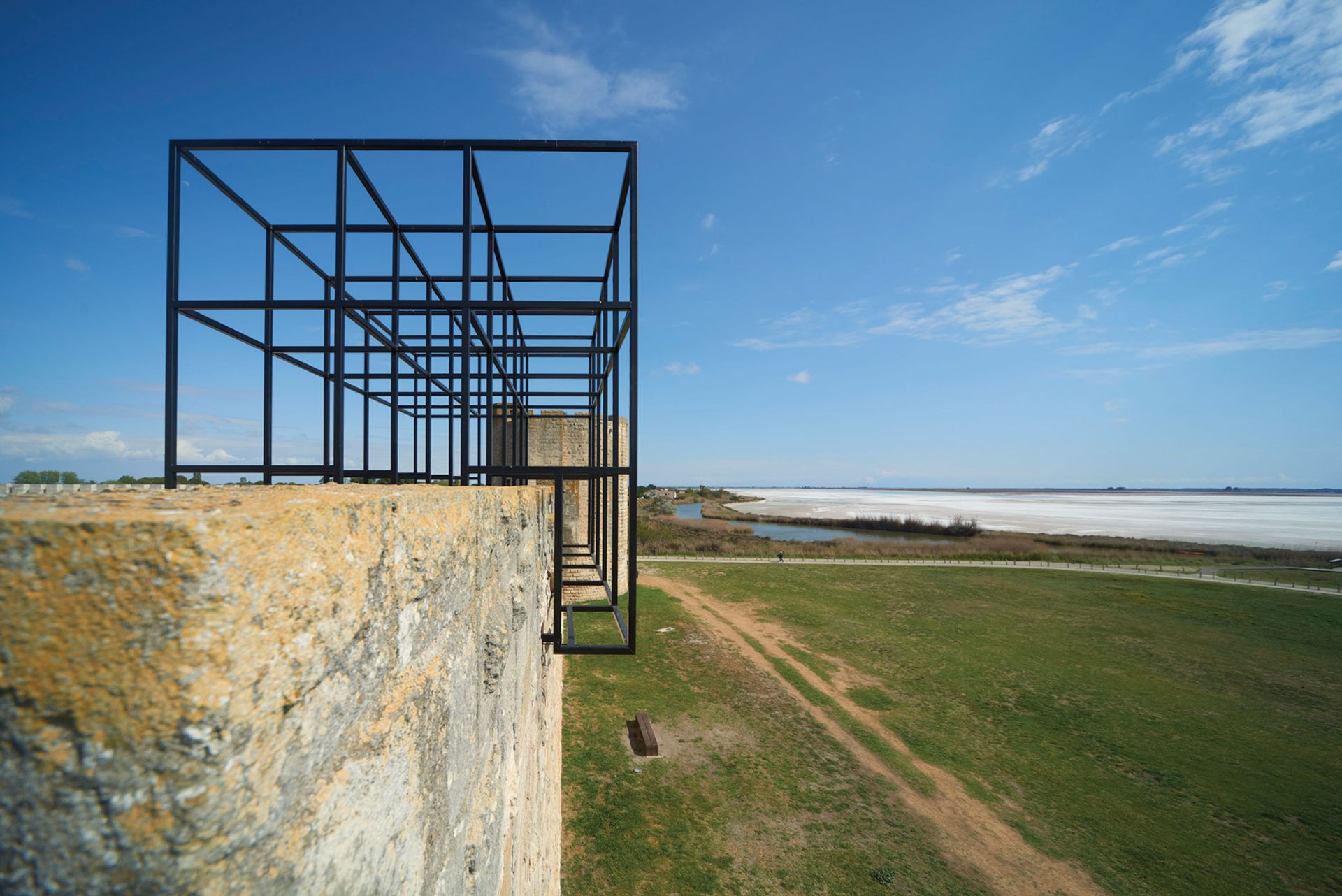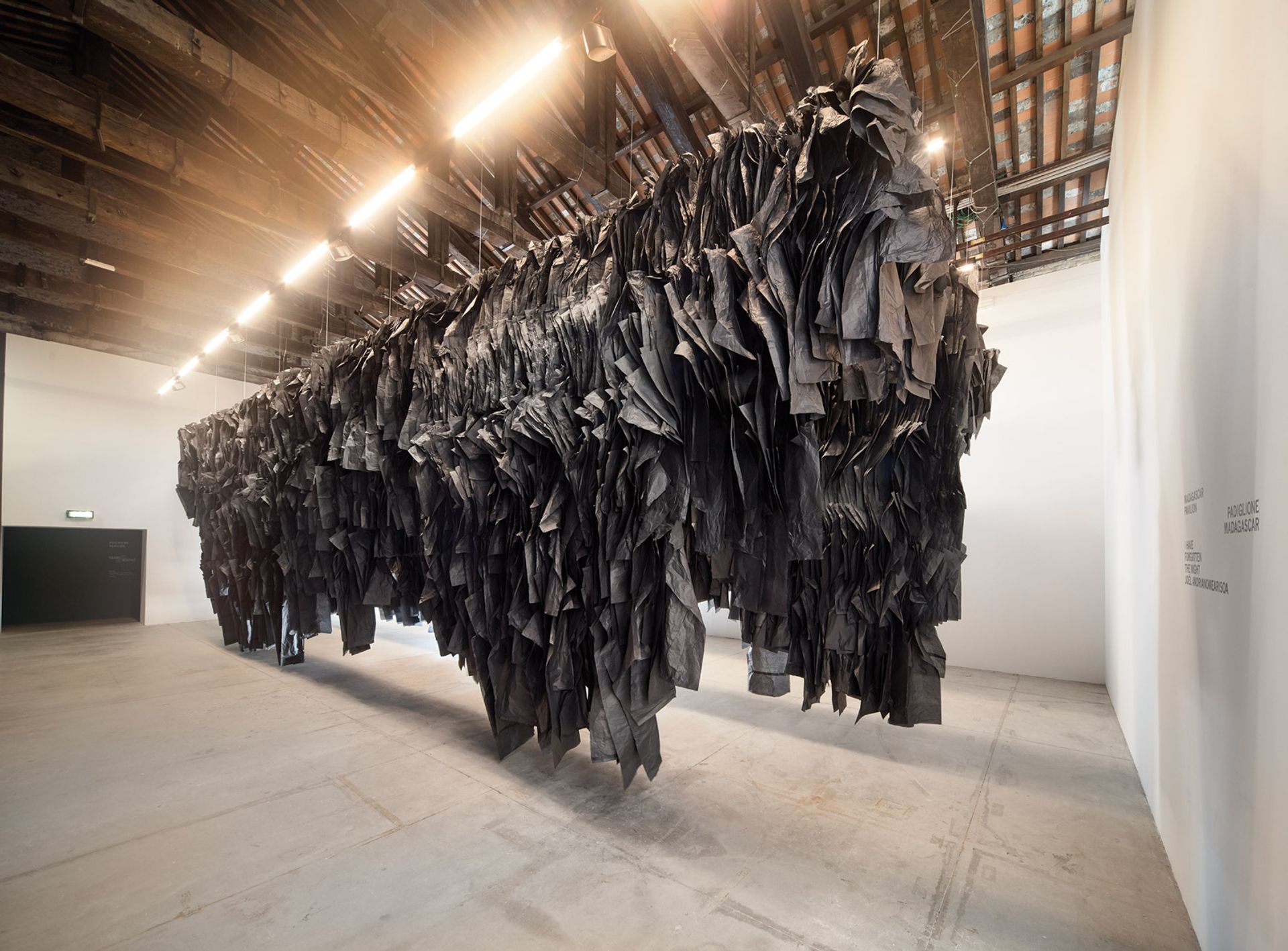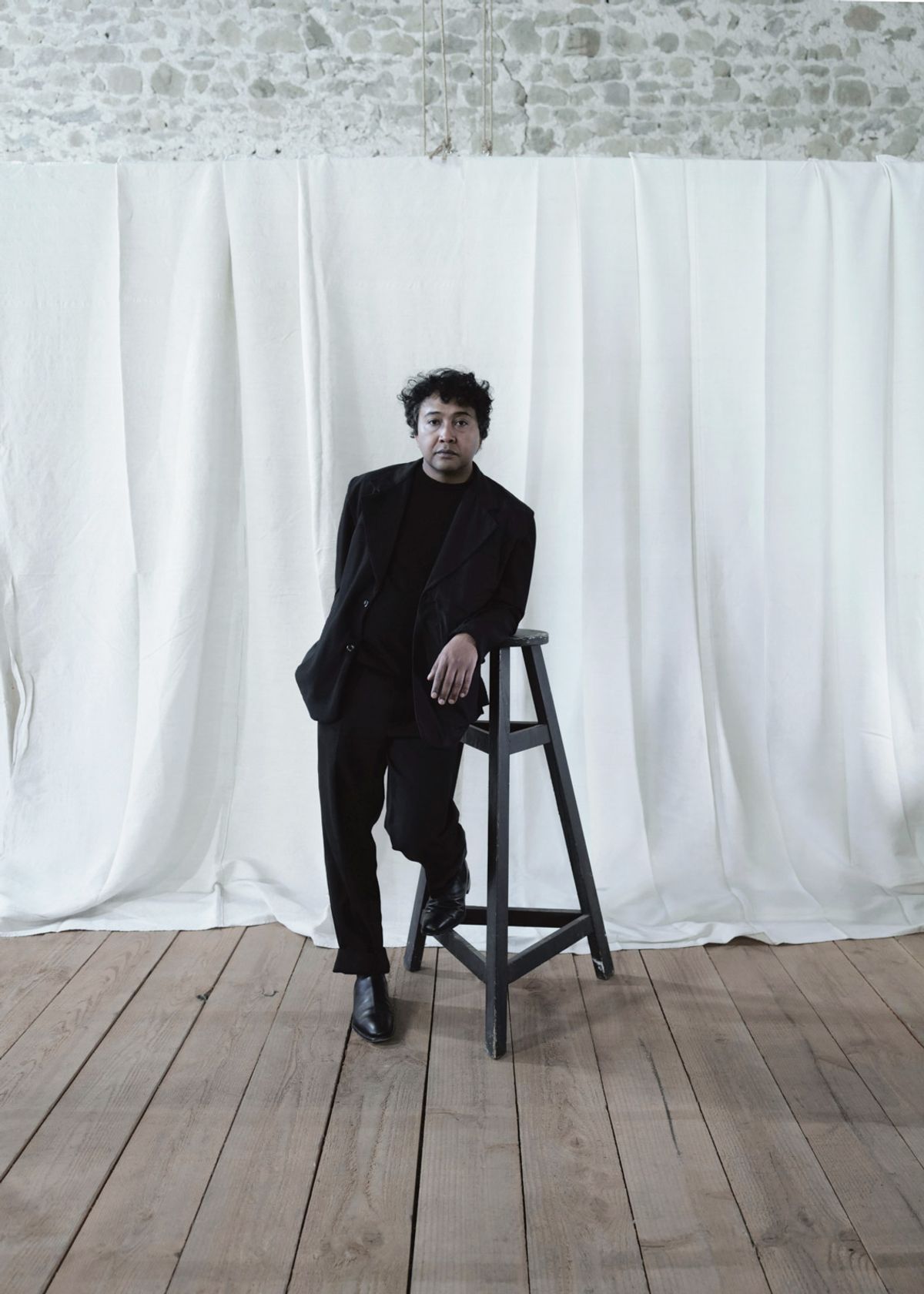Joël Andrianomearisoa was born in Antananarivo, Madagascar, and studied architecture at Paris’s École Speciale d’Architecture. He exhibited for the first time at the French capital’s Musée d’Art Moderne de Paris (MAM) in 2000 in the group show Paris Pour Escale (Paris stopover) and is currently exhibiting in MAM’s neighbouring museum, the Palais de Tokyo, in the group show Ubuntu, a Lucid Dream—his neon Ici nous portons tous les rêves du monde (Here we reach all the dreams of the world, 2021) hangs over the museum’s entrance.
Andrianomearisoa’s work takes multiple forms, including photography, textiles, sculpture and installation, but often relates to his architectural studies in its engagement with space and environment. He has also strayed into other disciplines, including collaborations with Christian Dior and the perfume brand Diptyque. Black is the dominant colour of his work.
He represented Madagascar at the Venice Biennale in 2019, the first time his country had participated. He spoke to The Art Newspaper on a recent return visit to Venice ahead of the opening of Hakanto Contemporary, a new Antananarivo museum dedicated to contemporary Malagasy art, where he has been appointed as artistic director.

Andrianomearisoa’s sculpture, Dancing with the Angels (2021), at the Palais de Tokyo, one of his large-scale pieces that nod to
his architectural training Courtesy of Sabrina Amrani Gallery and the artist
The Art Newspaper: How would you describe your upbringing?
Joël Andrianomearisoa: I was born in 1977, in Antananarivo, the capital of Madagascar, high up in the mountains. We were a very normal family, without any relationship to art. My grandfather was an engineer. My mother worked in a bank and my father was a teacher. I was brought up in a very classical, traditional way. Art appeared for the first time when I was about 15 or 16; I remember telling my parents I had a desire to pursue some kind of creativity, but I didn’t know what kind. I remember, for some years, I felt a little bit lost. I tried many things in small ways—design, fashion, art. But I didn’t really know what I was doing. That began to change when I decided to study architecture in Paris.
Madagascar has more endemic and unique species of animals and plants than anywhere on the planet. How would you describe it to someone who has never experienced it?
I can’t answer the question because I don’t know enough about my country. The beauty of Madagascar is its mystery. It is three times bigger than France; it is too big to understand, too much to embrace at the same time. But I know Antananarivo well; it’s a city between Rome, London and Lisbon. There’s a lot of British sophistication, because we were a British colony. We love drinking tea, we have a long tradition of British architecture; some of our streets look like London. But we also take a lot of inspiration from Portugal, from France, from Italy. We are close to Africa, but, culturally, sometimes I think we are more related to Asia. If I travel to Japan or Thailand or India, I find things that remind me of Antananarivo.

Joël Andrianomearisoa, views of the exhibition Brise du rouge soleil. Towers and ramparts of Aigues-Mortes, 2021. Courtesy Rubis Mécénat. Photos: ©Joël Andrianomeariso,
You left Antananarivo to study in Paris as a teenager. What was your initial experience of Paris like?
I remember, when I arrived there, feeling I had discovered life. It was very personal to me. In Paris, there is something to do all the time; the activity, the energy, the diversity—it’s always there. When I went back to Antananarivo, at night it was more quiet than I could have imagined. I studied at the École Speciale d’Architecture in Paris until I was 24. I studied architecture, but they were always telling me that architecture is not the point. It’s more the discussion about the idea of architecture. That was interesting to me. As I studied, I began to become surrounded by contemporary art. I met some interesting people in Paris; curators, artists, writers. They became my education, my school. I graduated as an architect and I had the option of perhaps returning to Madagascar and building a primary school or something. But I really jumped into art.
At what point in your life did you start to identify as an artist?
It took me more than ten years to decide properly I was an artist. But the decision was not only mine, actually. The decision came more from the professional world I was in. I spent the decade going through a period of research and experimentation. But I was not ready. It was only when I began to properly show my work, when I started to be represented by a gallery, when I entered the market in some way, that I was able to define myself as an artist. But I don’t think I decided alone that I would have a career as an artist. I think other professionals decide that for you.
How do you develop your ideas?
My work often comes from within myself. This can take time, because I can’t tell you exactly when and where I will get an idea. My ideas can come to me on a plane or a train, in bed or in a restaurant. It can come from the look in someone’s eye or in an emotion I suddenly experience. But it always starts with words. I am in Venice now, and on the plane into Venice I found myself writing quickly in my notebook. At some point these words begin to turn into drawings, then sketches. And at that point my architectural process begins, and it becomes about space, materials, temporalities.

Installation view of Madagascar's 2019 Venice Biennale pavilion
You showed in the Madagascar pavilion at the 2019 Venice Biennale. If Madagascar is too big to understand, how did you represent it?
Representing a country at Venice is more than just a challenge, because you’re not just an artist. You become, at a certain point, an ambassador; of your art and also of your country. You carry your country on the top of your head in front of the world. And this is heavy. The day I realised I would represent Madagascar in a pavilion at the Arsenale in Venice, I was proud, happy and excited. But the second day, I thought: “How am I going to deal with this?” I found a lot of people were suddenly wanting to give me advice; telling me I had to represent this or that and include this traditional thing or take inspiration from that part of our culture. As I was listening to them, I felt myself getting bored, and I felt I was becoming more stupid. So I decided to remove everything. I said to myself: “I’m going to represent Madagascar, but, to represent it better, to love it better, I’m going to forget Madagascar.” I decided to be sincere with myself. And to say that I am a legacy of the country. I’m from Madagascar. My blood is my legacy. I am part of it.
You have two upcoming exhibitions—at Zeitz Mocaa in Cape Town and at Macaal in Marrakech. What aspects of your practice will you explore in these very distinct spaces?
I am the atrium artist this year for Zeitz Mocaa. It’s a big mission. It’s going to connect to the show I did in Venice. I will create a huge installation made with black paper. It will be a labyrinth. I want it to be very radical. For Marrakech, I am trying to work beyond the idea of a solo show. We’re going to invade the museum; the gardens, the stairs, the bathrooms, the shops. I will show paintings, drawings, textiles. There will be sculptures in the garden, objects for the shop, food designed by me in the restaurant. I will be working with Moroccan techniques throughout and everything will be produced in Morocco. I will move my studio there, and we will work, create, think and produce in this very inspiring location.
Biography
Born: 1977 Antananarivo, Madagascar
Lives: Antananarivo and Paris
Education:2003 Diplôme d’architecte,École Spéciale d’Architecture, Paris
Key shows: 2021 Kunsthalle Praha, Prague; Musée de l’Histoire de l’Immigration, Paris; 2020 Dallas Contemporary; 2020 Biennale of Sydney; 2019 Venice Biennale; Manifesta, Lyon; 2018 MaXXI, Rome 2017 National Museum of African Art, Washington, DC; Museu Afro Brasil, São Paulo; 2016 Biennale of Contemporary African Art, Dakar, Senegal; 2013 Palais de Tokyo, Paris; Grand Palais, Paris; 2008 Studio Museum, Harlem, New York; 2005 Centre Pompidou, Paris; Hayward Gallery, London; 2000 Musée d’Art Moderne de Paris
Represented by: Sabrina Amrani Gallery, Madrid
• Ny Fitiavanay/Our Love/Notre Amour, curated by Joël Andrianomearisoa, Hakanto Contemporary, Antananarivo, until 16 March; Ubuntu, a Lucid Dream, Palais de Tokyo, Paris, until 20 February; his exhibition at Zeitz Mocaa, Cape Town, opens in June and the show at Macaal, Marrakech, opens 23 September


